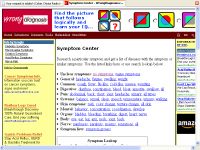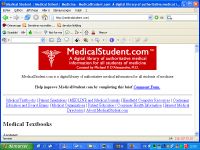How to Perform an Emergency TracheotomyThis procedure, technically called a cricothyroidotomy, should be undertaken only when a person with a throat obstruction is not able to breathe at all-no gasping sounds, no coughing-and only after you have attempted to perform the Heimlich maneuver three times without dislodging the obstruction. If possible, someone should call for paramedics while you proceed. What you will need
There will not be time for sterilization of your tools, so do not bother; infection is the least of your worries at this point.
How to Proceed
|
Monday, September 05, 2005
Emergency Tracheotomy
Emergency Tracheotomy: "How to Perform an Emergency Tracheotomy
Saturday, September 03, 2005

Symptom Center - WrongDiagnosis.com: "Symptom Center
Research a particular symptom and get a list of diseases with the symptom or similar symptoms. Use the listed links here or use search lookup below.
# Unclear symptoms: no symptoms, vague symptoms
# General: headache, fatigue, swelling, weight
# Common: cough, fever, flu-like, cold-like, nausea, vomiting
# Digestive: diarrhea, constipation, bleed, bloat, appetite, swallow, all
# Pain: abdominal, back, chest, joint, headache, urinary, all types
# Systems: balance, sexual, sleep, speech, temperature, urinary, walking
# Skin symptoms: rash, color change, texture change, all skin
# Mental: behavior, concentration, coordination, develop
# Organs: bladder, bleeding, breathing, digest, heart, nerve
# Body: eye, ear, leg, arm, neck, joint, back
# Nerve: numbness, paralysis, spasms, sensations, all
# Symptom lists: symptom groups"
nilsen RHEVI
Symptom: No symptoms - WrongDiagnosis.com
NOSYMPTOMS these diseases don't have symptoms, but some are dangerous so how to diagnose them?
Symptom: No symptoms - WrongDiagnosis.com: "Symptom: No symptoms
No symptoms: The absence of noticable symptoms.
Introduction: Even if you have no symptoms, it is still possible that you can still be sick. There are numerous conditions that have no symptoms. In some cases, the condition may never have symptoms, and in others there may be no early warning signs but with symptoms later (e.g. the 'silent killers' such as hypertension, diabetes, high cholesterol, and several cancers such as colon cancer). Many of these conditions with no symptoms are on the list of under-diagnosed conditions because they can be missed. In addition to this list, there are other conditions that may only have mild or vague symptoms."
Symptom: No symptoms - WrongDiagnosis.com: "Symptom: No symptoms
No symptoms: The absence of noticable symptoms.
Introduction: Even if you have no symptoms, it is still possible that you can still be sick. There are numerous conditions that have no symptoms. In some cases, the condition may never have symptoms, and in others there may be no early warning signs but with symptoms later (e.g. the 'silent killers' such as hypertension, diabetes, high cholesterol, and several cancers such as colon cancer). Many of these conditions with no symptoms are on the list of under-diagnosed conditions because they can be missed. In addition to this list, there are other conditions that may only have mild or vague symptoms."
Online Medical Symptom Checker -- Check your Symptoms
webmed system expertOnline Medical Symptom Checker -- Check your Symptoms: "Check Your Symptoms: WebMD Symptom Checker
Need information as you determine what to do about your symptoms? Get help figuring them out by answering a series of questions. To get started, click on male or female, regardless of age, then the part of the body that is troubling you.
Male Female"
Need information as you determine what to do about your symptoms? Get help figuring them out by answering a series of questions. To get started, click on male or female, regardless of age, then the part of the body that is troubling you.
Male Female"
Daryl's TCP/IP Primer
Daryl's TCP/IP Primer: "This document is designed to give the reader a reasonable working knowledge of TCP/IP subnetting, addressing, and routing. It is not intended to be complete, or to cover all issues. This is targeted toward LAN administrators just moving to TCP/IP, however it should help anyone who wants to know a little (more) about how TCP/IP works. This document does not, generally, apply to dial-up SLIP/PPP connections."
Ce document est conçu pour donner au lecteur une connaissance fonctionnante raisonnable de TCP/ip subnetting, adressant, et conduisant. On ne le prévoit pas pour être complet, ou pour couvrir toutes les issues. Ceci est visé vers des administrateurs de LAN se déplaçant juste à TCP/ip, toutefois il devrait aider n'importe qui qui veut savoir (plus) au sujet de la façon dont TCP/ip fonctionne.
Ce document est conçu pour donner au lecteur une connaissance fonctionnante raisonnable de TCP/ip subnetting, adressant, et conduisant. On ne le prévoit pas pour être complet, ou pour couvrir toutes les issues. Ceci est visé vers des administrateurs de LAN se déplaçant juste à TCP/ip, toutefois il devrait aider n'importe qui qui veut savoir (plus) au sujet de la façon dont TCP/ip fonctionne.
Medical Student | Medical School | Medicine - MedicalStudent.com: A digital library of authoritative medical information for all students of medicine
Medical Student | Medical School | Medicine - MedicalStudent.com: A digital library of authoritative medical information for all students of medicine
mpianatra medecine ve ianao?
Ty tena ilainao mihitsy an
fa en anglais mazava ho azy
mpianatra medecine ve ianao?
Ty tena ilainao mihitsy an
fa en anglais mazava ho azy
ehc.com Corporate Site - Virtual Body
ehc.com Corporate Site - Virtual Body: "

"
Anatomie
raha te hianatra anatomie de ty tsara be
Whoever wants to learn a bit about anatomy try this
need flash player installed on ur PC and an acceptable connection speed

"
Anatomie
raha te hianatra anatomie de ty tsara be
Whoever wants to learn a bit about anatomy try this
need flash player installed on ur PC and an acceptable connection speed
Subscribe to:
Posts (Atom)
